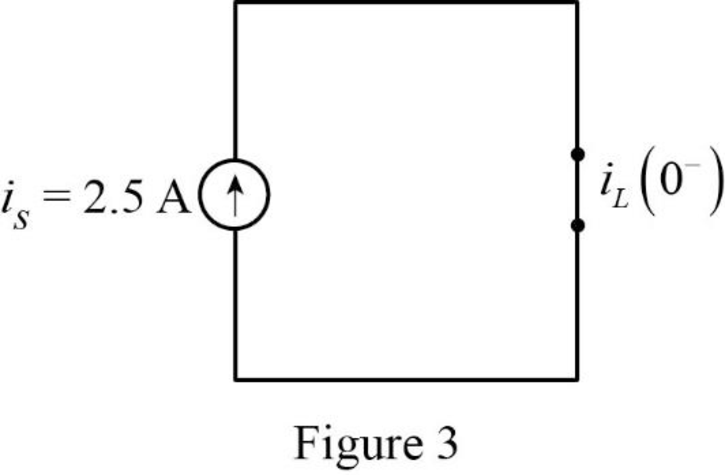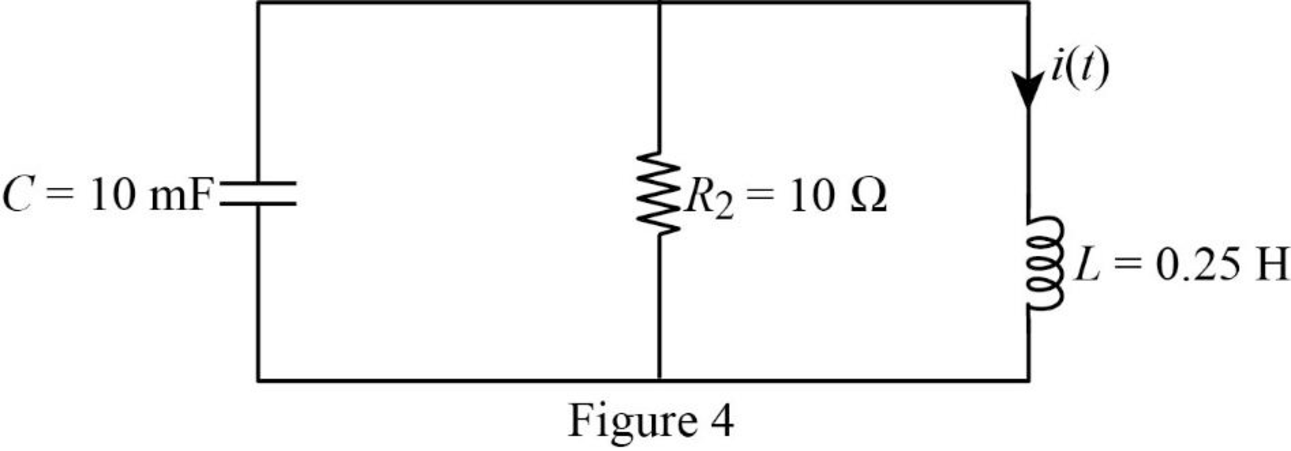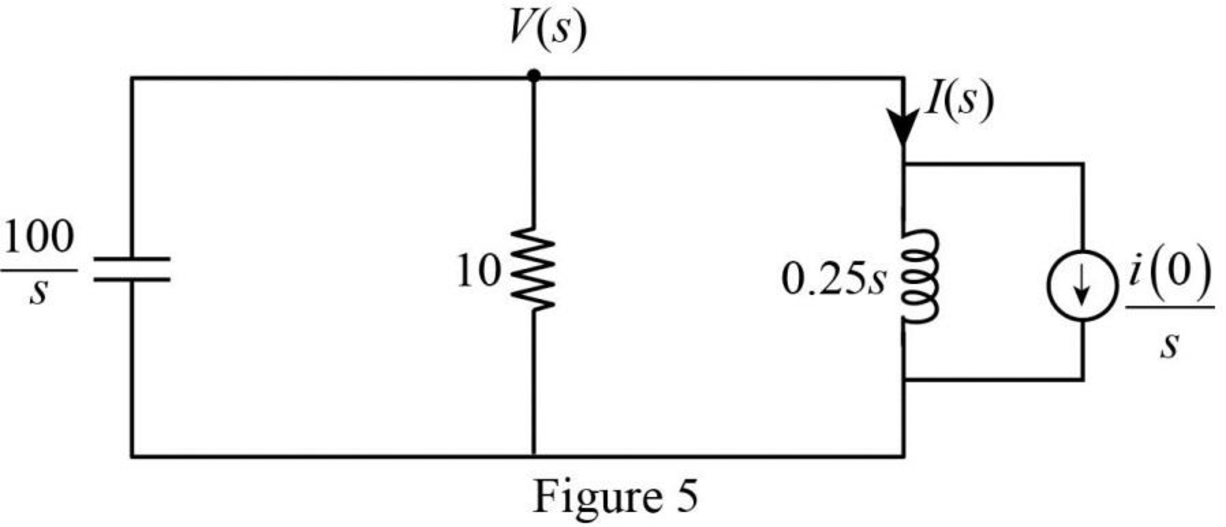
Find the expression of current
Answer to Problem 26P
The expression of current
Explanation of Solution
Given data:
Refer to Figure 16.49 in the textbook.
Formula used:
Write a general expression to calculate the impedance of a resistor in s-domain.
Here,
Write a general expression to calculate the impedance of an inductor in s-domain.
Here,
Write a general expression to calculate the impedance of a capacitor in s-domain.
Here,
Calculation:
The given circuit is redrawn as shown in Figure 1.

For a DC circuit, at steady state condition when the switch is in position A at time
Now, the Figure 1 is reduced as shown in Figure 2.

Refer to Figure 2, the short circuited inductor is connected in parallel with resistors
Now, the Figure 2 is reduced as shown in Figure 3.

Refer to Figure 3, the current flow through the inductor is same as the value of current source
Refer to Figure 3, there is no capacitor placed in a circuit. Therefore, the voltage across the capacitor is zero.
The current through inductor and voltage across capacitor is always continuous so that,
For time

Substitute
Substitute
Substitute
Using element transformation methods with initial conditions convert the Figure 4 into s-domain.

Apply Kirchhoff’s current law for the circuit shown in Figure 5.
Substitute
Simplify the above equation to find
From the equation (4), the characteristic equation is
Write a general expression to calculate the roots of quadratic equation
Comparing the equation (5) with the equation
Substitute
Simplify the above equation to find
Substitute the roots of characteristic equation in equation (4) to find
Take partial fraction for above equation.
The equation (7) can also be written as follows:
Simplify the above equation as follows:
Substitute
Simplify the above equation to find
Substitute
Simplify the above equation to find
Substitute
Refer to Figure 5, the current
Substitute
Assume,
Substitute equation (10) and (11) in equation (9).
Take partial fraction for equation (10).
The equation (13) can also be written as follows:
Simplify the above equation as follows:
Substitute
Simplify the above equation to find
Substitute
Simplify the above equation to find
Substitute
Take partial fraction for equation (11).
The equation (13) can also be written as follows:
Simplify the above equation as follows:
Substitute
Simplify the above equation to find
Substitute
Simplify the above equation to find
Substitute
Substitute
Apply inverse Laplace transform for above equation to find
Simplify the above equation to find
Conclusion:
Thus, the expression of current
Want to see more full solutions like this?
Chapter 16 Solutions
EE 98: Fundamentals of Electrical Circuits - With Connect Access
- Please do question 3 and 4 of this question, the first part is submitted as a separate question due to the limit. Thank you, I will give positive feedback. Please explain each step clearlyarrow_forwardIf the circuit shown in Fig. P12.38(a) is excited by thecurrent waveform is(t) shown in Fig. P12.38(b), determine i(t)for t ≥ 0, given that R1 = 10 W, R2 = 5 W, and C = 0.02 F.arrow_forwardPlease explain each step clearly and include a proper image of what the block diagram and plot must look like. thank youarrow_forward
- A three-phase, 480-V, 60-Hz, 6-pole, Y-connected induction motor has its speed controlled by slip power. The circuit parameters are given: Rs=0.06 ohms, Rr=0.05 ohms, Xs=0.2 ohms, Xr=0.3 ohms and Xm=6 ohms. The turn ratio of the rotor to stator winding is n=0.8. The no-load losses of the motor are equal to 150 W. The rotor and stator cupper losses are equal to 249.21 W. The slip power losses are estimated to 8000W. The load torque is 173.61 N.m. at 700 rpm. The efficiency is equal to: Select one: a. 71.5% b. None of these c. 81.5% d. 91.5%arrow_forwardQuestion 1: A 3 phase, 10 kW, 1700 rpm, Y- connected 460 V, 60 Hz, 4 poles, Y-connected induction motor has the following parameters: Rr = 0.2 ohms, Xs = 0.8 ohms, Xr = 0.8 ohms, Xm = 20 ohms. The no load losses are neglected. The rotor speed is assumed to be constant equal to 1700 rpm. The V/F control method is applied. The stator resistance is negligible. If the base synchronous speed is 188.5 rad/s and the voltage frequency ratio is 1.405, then the maximum torque Tm and the corresponding speed w at 30 Hz are equal to: Select one: a. 350 N.m and 70.69 rad/s b. None of these c. 350 N.m and 164.94 rad/s d. 700 N.m and 164.94 rad/s Question 2: A 3 phase, 10 kW, 1750 rpm, Y- connected 460 V, 60 Hz, 4 poles, Y-connected induction motor has the following parameters: Rs = 0.5 Ohms, Rr = 0.3 Ohms, Xs = 0.9 Ohms, Xr = 0.9 Ohms, Xm = 25 Ohms. The no load losses are neglected. In this type of control the developed torque is proportional to the square of the statoric voltage. In this part, the…arrow_forwardPlease explain each question vlearly and explain how to do it. Thank you, I will give pos feedbackarrow_forward
- Don't use ai to answer I will report you answerarrow_forwardDon't use ai to answer I will report you answerarrow_forward12.43 For the circuit shown in Fig. P12.43, determine Vout (1) given that R₁ = 1 kQ, R₂ = 4k, and C = 1 μF, and (a) v(t)=2u(1) (V), (b) s(t)=2 cos(10001) (V), (c) vs(t) = 2e u(t) (V). R1 Us(1) + R2 Dout(1) Figure P12.43 Op-amp circuit for Problem 12.43.arrow_forward
- 12.41 The circuit shown in Fig. P12.41 was introduced in Problem 5.68. Then, a time-domain solution was sought for Dout, (1) and Dout₂ (1) for 10, given that v₁(1) = 10u(t) mV, Vcc 10 V for both op amps, and the two capacitors had no change prior to t = 0. Analyze the circuit and plot Dout, (t) and Dout (1) using the Laplace transform technique. 4μF 5 μF Οι 5 ΚΩ Dout 1 MQ Dout2 + Vcc = 10 V Vec = 10 V Figure P12.41 Circuit for Problems 12.41 and 12.42.arrow_forward12.38 If the circuit shown in Fig. P12.38(a) is excited by the current waveform is(t) shown in Fig. P12.38(b), determine i(t) for 1 > 0, given that R₁ = 102, R2 = 5 92, and C = 0.02 F. is(t) R₁ i(t) R₂ is(t) 1.5 A 1.5A | 1 A 0.5 A- M 0.5A- (a) Circuit www. (b) Waveform 0 = 4 rad/s t Figure P12.38 Circuit for Problems 12.38 to 12.40.arrow_forwardEXERCISE 1: Consider the waveguide of Example Calculate the phase constant, phase velocity and wave impedance for TE10 and TM11 modes at the operating frequency of 15 GHz. = 192.4 . For Answer: For TE10, B = 615.6 rad/m, u = 1.531 × 108 m/s, TE 529.4 rad/m, u = 1.78 x 10 m/s, TM = 158.8 Q. TM11, B Example 1: A rectangular waveguide with dimensions a = 2.5 cm, b = 1 cm is to operate below 15.1 GHz. How many TE and TM modes can the waveguide transmit? if the guide is filled with a medium characterized by σ = 0, &=4&o Hr = 1° Calculate the cutoff frequencies of the modes.arrow_forward
 Introductory Circuit Analysis (13th Edition)Electrical EngineeringISBN:9780133923605Author:Robert L. BoylestadPublisher:PEARSON
Introductory Circuit Analysis (13th Edition)Electrical EngineeringISBN:9780133923605Author:Robert L. BoylestadPublisher:PEARSON Delmar's Standard Textbook Of ElectricityElectrical EngineeringISBN:9781337900348Author:Stephen L. HermanPublisher:Cengage Learning
Delmar's Standard Textbook Of ElectricityElectrical EngineeringISBN:9781337900348Author:Stephen L. HermanPublisher:Cengage Learning Programmable Logic ControllersElectrical EngineeringISBN:9780073373843Author:Frank D. PetruzellaPublisher:McGraw-Hill Education
Programmable Logic ControllersElectrical EngineeringISBN:9780073373843Author:Frank D. PetruzellaPublisher:McGraw-Hill Education Fundamentals of Electric CircuitsElectrical EngineeringISBN:9780078028229Author:Charles K Alexander, Matthew SadikuPublisher:McGraw-Hill Education
Fundamentals of Electric CircuitsElectrical EngineeringISBN:9780078028229Author:Charles K Alexander, Matthew SadikuPublisher:McGraw-Hill Education Electric Circuits. (11th Edition)Electrical EngineeringISBN:9780134746968Author:James W. Nilsson, Susan RiedelPublisher:PEARSON
Electric Circuits. (11th Edition)Electrical EngineeringISBN:9780134746968Author:James W. Nilsson, Susan RiedelPublisher:PEARSON Engineering ElectromagneticsElectrical EngineeringISBN:9780078028151Author:Hayt, William H. (william Hart), Jr, BUCK, John A.Publisher:Mcgraw-hill Education,
Engineering ElectromagneticsElectrical EngineeringISBN:9780078028151Author:Hayt, William H. (william Hart), Jr, BUCK, John A.Publisher:Mcgraw-hill Education,





